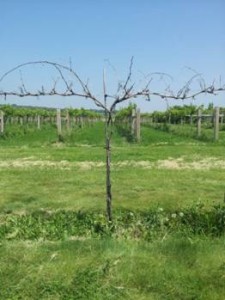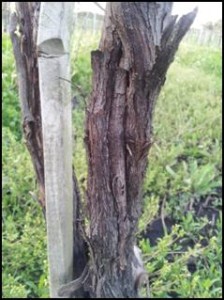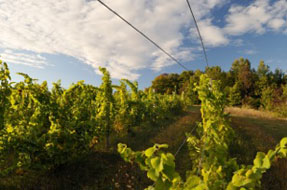Do You Know Where Your Vineyard is Today?
After most of Northern Illinois sustained severe winter temperatures and was caught in a polar vortex for what seemed like an eternity, spring has finally arrived. Are your grapevines beginning to show bud break? Are you anticipating more buds to burst forth? Do you realize, that most, if not all areas of Illinois are well past bud break on all varieties and vines are at bloom stage or beyond? The question many of us need to ask ourselves is, whether we really know where our vineyard stands as it relates to cold damage sustained during January’s 2014 severe winter temperatures.
This question is one that is not so easy to answer as it may take some time before growers recognize the extent of the winter cold damage to their vines. On the hardiest of varieties, such as Frontenac, Marquette, St Pepin, Petite Pearl, Marechal Foch, and Sabrevois, growers may be seeing some bud damage on spurs; on moderately hardy to tender varieties, such as Corot Noir, Noiret, and Traminette, growers may find dead cordons, injured trunks and in some cases, dead vines altogether.
For growers who had done bud assessments prior to dormant pruning, you may have already been given significant insight as to the viability of buds/spurs, canes and trunks. For growers who had foregone doing a bud assessment and are now seeing minimal bud break, erratic bud break or no bud break, it is a very good indication that your vines have been injured or in a worst case scenario, killed.
There is even more bad news: If your vines are showing some signs of life with bud break along the trunks or at the very ends of cordons, you may not be out of the woods yet when it comes to cold injury. In some situations, latent buds may be breaking indicating that there is some life left in the vine but for all intensive purposes, if you are finding vines with over 75% bud mortality, its best to plan on renewing your trunks or replacing the vine. This means, DO NOT remove the suckers that you may see shooting up from near ground level. These suckers may be the only opportunity you will have to try and renew your damaged vines, if you decide to re-train.
Just one note of caution here: If you have vines that are grafted onto rootstock, be sure the buds that are pushing forth are from above the rootstock joint. You want to be sure to train up shoots of the varietal and not rootstock shoots. Trying to save a vine with over 75% bud damage may yield unsatisfactory results resulting in poor bud break and possible vine death later in the season, and in these cases, a grower may wish to replace the vine altogether. The decision to replace or re-train is a decision only a grower can make based on his/her individual situation.
In cases where you have determined that you will need to train these suckers into new trunks, select several of these canes and train upward, just as if they were newly planted vines. You want to choose several, at least three to four, so the vine will spread its vigor out into these shoots produce healthier, stronger trunks rather than two rapidly growing shoots of possibly weaker wood. Eventually, two of the healthiest shoots will be selected to serve as the new structure for your vine, and the remaining shoots can be pruned away once you have determined your vines are once again in good health. Leave additional sucker shoots that appear at the base to aid in the photosynthesis process. This will aid your vine in acquiring the necessary energy it will need for growth.
The image to the left shows the unmistakable sign of a trunk splitting from cold damage. While this image depicts obvious trunk damage, your damage may not always be so readily apparent. Trunks can be damaged without obvious visual signs of injury (cracking & splits) and this injury can manifest itself later into the season with signs of crown gall or sudden vine collapse. For these reasons, the extent of all winter injury may not yet be fully understood, therefore, when removing suckers at the bottom of your vines it is best to leave some as to air on the safe side than regret hasty decisions later on.
The picture below was taken May 23rd and is of a block of NY Muscat. This variety is rated for Zone 6, has been grafted onto 3309 rootstock, and trellised on GDC. During the polar vortex, temperatures in this vineyard plummeted to -18 degrees Fahrenheit. Temperature, varietal selection, and location all played a role in this variety sustaining almost total bud death. Arrows indicate where bud break has occurred. Notice the vines in the background of the same variety. One can see similar bud break throughout the rows of the whole block.

Based on quick assessment of this particular variety, 100% of the vines sustained almost total bud death. These vines have suffered massive winter injury not only to buds, but also to canes, cordons and trunks. Essentially, a grower is not left with many choices. The best recommendation in this situation is to replace this varietal with a hardier variety or replant this block and take a chance with future winter survival. A third option, though not always feasible in every situation, is to graft a hardier cultivar onto the surviving rootstock.
If the decision to replant has been made, growers may need to act quickly to try and secure replacement vines. Many nurseries may not have adequate stock to support wide-spread vine sales especially regarding the more popularly grown cultivars.
While growers find themselves being initially affected by this, the ramifications of the lingering effects from the polar vortex may reach even further affecting the capacity of a winery to reach its annual production goals. With a possible shortage of crop, or no crop on certain varieties, wineries may find themselves faced with a diminished yield available for purchase and should make plans now to contact their growers and get a precise view of potential harvestable crop. In worst-case-scenarios, wineries may need to source additional product.
A cold damage assessment survey is currently being prepared. It will be distributed shortly. Please take the time to accurately assess your vineyard and provide the necessary feedback. While this may seem like a time consuming chore, the information is extremely important to our industry. It will also provide you with valuable information regarding your vineyard.
For those growers new to conducting assessments, here are a few pointers to get you started. Be sure to examine different cultivars separately from one another. Give damage assessments in terms of percentage. Below is an example of a formula that can be used on bud/cordon or trunk assessments. When doing cordon and trunk assessments, be sure to adjust your letter representation in the formula accordingly. It is advised that you conduct a bud assessment and carefully record the number of living buds (Lb where ‘L” means ‘living” and the superscript ‘b” indicates that the value of ‘L” is a bud) as well as the number of dead buds (Db). To determine the percentage of bud death, follow this given formula:
Db(Lb+Db)*100=% of bud death
If your vines have lost slightly under half of their primary buds, and this pattern seems to be repeated with all the other vines in the block, you would estimate damage at 40-49% primary bud loss of that variety. The same would go for loss of cordons, trunks, and total death of vines in any given block.
For more information on conducting a damage assessment, send inquiries to Denise@illinoiswine.com.
Denise Cimmarrusti is the Viticulture Specialist for the Illinois Grape Growers and Vintners Association, Northern Region





